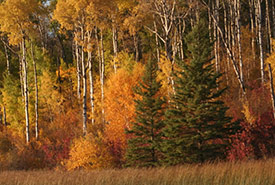The science of fall colours

Riding Mountain, MB (Photo by Cathy Shaluk)
Canada’s forests are home to many colourful characters. Throughout the year you’ll see vibrant wildflowers, decorated songbirds and gaudily painted insects and fungi. Each has its moment of glory in the annual forest parade. But the trees themselves are a monochrome of green. The mosaic of forest foliage has its own beauty, but it is still pretty homogeneous. That is, until trees get a chance to shine.
Trees are green because they are slaves to chlorophyll, the super-abundant “green” pigment at the centre of photosynthesis. Trees live to create, protect, feed, water and provide light to the leaves that house these sugar factories. In the fall, shortened day length triggers deciduous trees to shut down these operations. The chlorophyll breaks down, often with spectacular results. Blasts of colour — from banana yellows and fluorescent-vest oranges to candy-apple red — shine through and set branches ablaze.
The yellows and oranges come from carotenoids, the colouring agent of corn and carrots. These pigments are chlorophyll side-kicks whose colours are masked while chlorophyll is in the limelight. Yellow is probably Canada’s most common fall tree colour. The vast boreal forest shimmers with gold in the fall because leaves of poplars and birches, the common deciduous trees there, are packed with carotenoids.
The same goes for our mountain forests and for our great prairie rivers, whose valleys get painted with bands of gold by the same trees.
Story continues below the slideshow.
Reds and purples are the colours of anthocyanins, pigments that are products of surplus sugar in leaves. Red and sugar maples are famous for brilliant reds, which can intensify with warm, bright days and cool nights. This process also turns the lobed leaves of white oak, one of my favourite trees, a soft lavender colour. It is this diversity of tree species that makes our eastern forests stand out in the fall. Here, the yellows of poplar, birch, hickory and ash mix with the reds, pinks and purples of maples, oaks and cherries. Each tree and each leaf portrays a different pattern, and exhibits a slightly different set of new, true colours.
Coniferous trees also get into the act. Tamarack has needles that turn yellow in the fall and eventually fall off like deciduous leaves. Then new needles, bursting with chlorophyll, grow again in the spring.
There is a narrow window to view this amazing fall phenomenon at its peak, but it is worth the walk. I sincerely hope you get a chance to get out to subtly soak in some of this hidden variety – now revealed – that makes up the natural world. You’ll discover that in nature, as with people, there are often other true colours that can shine through, when given a chance.
This blog entry also appeared in the Huffington Post



